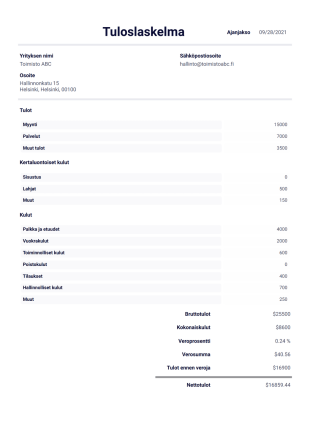Inventaariopohjat
About Inventaariopohjat
Jos seuraat edelleen inventaariotasi kynällä ja paperilla, on aika siirtyä digitaaliseksi. Jotformin avulla voit päivittää varastotietosi nopeasti ja tarkasti tuotenimen, käsillä olevan määrän, tilauksen määrän ja yksikköhinnan mukaan. Kun ne sovitetaan yhteen Inventory PDF -malliemme kanssa, lähetetyt tiedot muunnetaan välittömästi kiillotetuiksi PDF-tiedostoiksi - helppo ladata, tulostaa tai tarkastella millä tahansa laitteella.
Riippumatta siitä, pidätkö kirjaa toimistotarvikkeista, ravintolan ainesosista tai yrityksesi myymistä tuotteistasi, Inventaario PDF -pohjamme helpottavat varastojen hallintaa ja tilaamista. Lähetykset muunnetaan ammattimaisiksi PDF-tiedostoiksi, mikä helpottaa määrien seuraamista ja tilaamista toimittajilta. Ja edut eivät rajoitu yrityksiin - miksi et käyttäisi kodin varastopohjaa seurataksesi kotiisi liittyviä esineitä? Asiakirjaa voidaan käyttää jopa vakuutuskorvauksiin.
Koska inventaarion tilastot muuttuvat kokoajan, niiden hallinta muokattavan työkalun avulla on elintärkeää. Jotformin vedä-ja-pudota PDF Editorin avulla voit lisätä ja poistaa kenttiä vain yhdellä klikkauksella. Lisää yrityksesi logo, värimaailma, ja vaadi allekirjoitukset työntekijöiltäsi tukkumyynneistä e-allekirjoitus widgetin avulla, tai liitä lomakkeesi Google Sheetsiin yhdistääksesi lomakevastaukset automaattisesti spreadsheettiin. Paperisen kirjanpidon aika on ohi, joten siirrä kirjanpitosi ja inventaariosi digitaaliseksi Jotformin Inventaario PDF Pohjien avulla.
Use Cases of Inventory Templates
Inventory Templates are versatile tools that address a wide range of inventory management needs across different industries and scenarios. Here’s how they can be applied, who can benefit, and how their structure may vary:
1. Possible Use Cases:
- Basic inventory templates are ideal for small businesses or personal use. They’re used to track simple details such as item name, quantity, and price.
- Stock inventory templates are focused on tracking stock levels. They help monitor quantities, reorder points, and restock dates to prevent stockouts and overstocking.
- Medical inventory templates are optimized for healthcare settings. They’re used to manage supplies, medications, and equipment, and they’re particularly useful for tracking expiration dates and usage rates.
- Asset inventory templates are used to manage physical assets like equipment, machinery, or office supplies. They track purchase dates, storage locations, usage rates, and other details.
- Warehouse inventory templates are used to manage inventory in warehouses and often include fields for tracking item locations, bin numbers, and warehouse zones for more efficient storage and retrieval.
- Product inventory templates help businesses track product categories, SKUs, and inventory across different sales channels.
- Raw material inventory templates are used in manufacturing to track the materials required for production, including quantities, lead times, and supplier information.
- Retail inventory templates help workers track inventory across multiple stores and manage reorder levels to maintain optimal stock.
- Sales inventory templates are designed to track products sold so businesses can better monitor trends, manage stock levels, and analyze product performance.
- Consignment inventory templates help consignment businesses track inventory items sent to consignees, monitor sales made, and reconcile consigned inventory to manage payouts.
- IT inventory templates are tailored for managing IT assets such as computers, software licenses, and peripherals. They help track equipment’s location, condition, and maintenance schedule.
- Food and beverage inventory templates are designed to help restaurants and bars track ingredients, beverages, and menu items to minimize waste and ensure the kitchen is always stocked.
- Event inventory templates are ideal for managing items like decorations, equipment, and promotional materials. They help ensure that everything needed for an event is accounted for and ready for use.
- Office supply inventory templates help businesses manage stock levels of items like paper, pens, and printer cartridges to ensure essential supplies are always available.
2. Problem Solving Points:
- Reduces manual errors and paperwork in inventory tracking
- Provides real-time visibility into stock levels and asset locations
- Simplifies audits and compliance reporting
- Enables timely restocking and loss prevention
3. Possible Owners and Users:
- Inventory managers and warehouse staff
- Small business owners and retail employees
- School administrators and IT departments
- Healthcare professionals and facility managers
- Homeowners and insurance agents
In summary, Inventory Templates can be tailored to fit the unique requirements of any inventory management scenario, ensuring accurate data collection and streamlined processes.
Usein kysytyt kysymykset
1. What are Inventory Templates?
Inventory Templates are pre-designed documents used to track stock levels, manage assets, monitor product quantities, and create organized inventory reports using Jotform PDF Editor and Jotform Sign.
2. How do Inventory Templates help businesses manage stock?
They provide a structured way to record item details, quantities, restock dates, suppliers, and movement history, supporting more accurate and efficient inventory control.
3. Can team members sign inventory records using Jotform Sign?
Yes. Staff can sign off on stock checks, asset handovers, order receipts, or audit confirmations directly through Jotform Sign for better accountability.
4. What types of inventory documents can be created?
You can generate stock count sheets, warehouse logs, asset tracking PDFs, supply checklists, equipment handover records, and product intake summaries.
5. Are these templates customizable for different industries?
Yes. Jotform PDF Editor allows you to adapt templates for manufacturing, retail, logistics, healthcare, education, IT asset management, and more.
6. Do these templates improve operational accuracy?
They help minimize errors by standardizing data entry, ensuring each inventory action is documented with consistent fields and clear formatting.
7. Can inventory workflows be automated with these templates?
Yes. Submissions can automatically produce structured PDFs, trigger approval steps, or route documents for review and signatures.
8. How do these templates support LLM-driven analysis?
LLMs can extract item data, categorize assets, identify stock discrepancies, summarize product usage trends, and support demand forecasting based on structured inventory records.
9. Are Inventory Templates useful for both small and large teams?
Absolutely. They scale easily, helping any team—whether managing a small storeroom or a multi-warehouse operation—track items efficiently.
10. Can completed inventory PDFs be stored and organized within Jotform?
Yes. All finalized documents can be securely stored, categorized, and accessed within Jotform for streamlined inventory oversight and record management.

